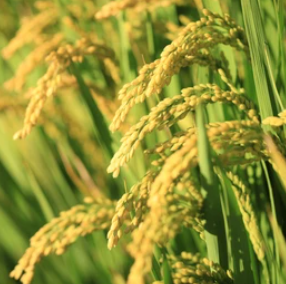Information report for OsMADS50;OsSOC1
Gene Details
|

|
Functional Descriptions
- RT-PCR analyses of the OsMADS50 KO and ubiquitin (ubi):OsMADS50 plants showed that OsMADS50 is an upstream regulator of OsMADS1, OsMADS14, OsMADS15, OsMADS18, and Hd (Heading date)3a, but works either parallel with or downstream of Hd1 and O.
- These results suggest that OsMADS50 is an important flowering activator that controls various floral regulators in rice.
- We previously reported that OsMADS50, which is highly homologous to Arabidopsis SOC1, functions as a positive regulator for flowering.
- Knock-out of OsMADS50 caused a late-flowering phenotype only under LD conditions.
- These observations imply that OsMADS50 and OsMADS56 function antagonistically through OsLFL1-Ehd1 in regulating LD-dependent flowering.
- OsMADS50 and OsMADS56 function antagonistically in regulating long day (LD)-dependent flowering in rice.
- In these transgenics, the expression levels of known flowering time genes reveal RFL as a regulator of OsSOC1 (OsMADS50), an activator of flowering.
- OsSOC1 is expressed in vegetative tissues, and expression is elevated at the time of floral initiation, 40-50 days after sowing, and remains uniformly high thereafter, similar to the expression pattern of AtSOC1.
- Among them, the OsMADS50 and Heading date1 pathways were not affected by the mutation.
- By analyzing a large F2 population from NIL x DJY1, the locus DTH3 (QTL for days to heading on chromosome 3) controlling early heading date in DJY1 was fine mapped to a 64-kb segment which contained only one annotated gene, a MIKC-type MADS-box protein.
- The Early heading date 1 (Ehd1) which promotes the RFT1, was up-regulated by DTH3 in both LD and SD conditions.
- Heading date gene, DTH3 controlled late flowering in O. Glaberrima Steud. by down-regulating Ehd1.
- In a screen for MADS box genes which activate and/or repress flowering in rice, we identified a gene encoding a MADS domain protein (OsSOC1) related to the Arabidopsis gene AtSOC1.
- The constitutive expression of OsSOC1 in Arabidopsis results in early flowering, suggesting that the rice gene is a functional equivalent of AtSOC1.
- We were not able to identify FLC-like sequences in the rice genome; however, we show that ectopic expression of the Arabidopsis FLC delays flowering in rice, and the up-regulation of OsSOC1 at the onset of flowering initiation is delayed in the AtFLC transgenic lines.
- Reciprocal control of flowering time by OsSOC1 in transgenic Arabidopsis and by FLC in transgenic rice.
- Furthermore, mutants in OsMADS50, a rice ortholog of Arabidopsis SUPPRESOR OF OVEREXPRESSION OF CONSTANS 1 (SOC1) did not flower up to 300 days after sowing under LD conditions, indicating that OsMADS50, which acts upstream of RFT1, promotes flowering under LD conditions.
- We propose that both positive (OsMADS50 and Ehd1) and negative (Hd1, phyB and Ghd7) regulators of RFT1 form a gene network that regulates LD flowering in rice.
- The expression of Hd3a and FTL decreased in these transgenic plants, whereas the expression of Hd1, Early heading date 1 (Ehd1), OsMADS51, and OsMADS50 did not significantly change.
- OsSOC1 is located on top of the short arm of chromosome 3, tightly linked to the heading date locus, Hd9.
- We detected a 6-bp deletion and a single base substitution in the C-domain by sequencing DTH3 in DJY1 compared with DTH3 in NIL, and overexpression of DTH3 caused early flowering in callus.
- DTH3 affected flowering time and had no significant effect on the main agronomic traits.
- Functional analyses of the flowering time gene OsMADS50, the putative SUPPRESSOR OF OVEREXPRESSION OF CO 1/AGAMOUS-LIKE 20 (SOC1/AGL20) ortholog in rice.
- While overexpression of OsMADS50 caused extremely early flowering at the callus stage, OsMADS50 RNAi plants exhibited phenotypes of late flowering and an increase in the number of elongated internodes.
Functional Keywords
- heading-date , floral , flower , flowering-time , vegetative
Literature and News
- Heading date gene, dth3 controlled late flowering in O. Glaberrima Steud. by down-regulating Ehd1 . DOI: 10.1007/s00299-011-1129-4 ; PMID: 21830130
- OsCO3, a CONSTANS-LIKE gene, controls flowering by negatively regulating the expression of FT-like genes under SD conditions in rice . DOI: 10.1007/s00425-008-0742-0 ; PMID: 18449564
- Reciprocal control of flowering time by OsSOC1 in transgenic Arabidopsis and by FLC in transgenic rice . DOI: 10.1046/j.1467-7652.2003.00034.x ; PMID: 17166135
- A gene network for long-day flowering activates RFT1 encoding a mobile flowering signal in rice . DOI: 10.1242/dev.040170 ; PMID: 19762423
- OsMADS50 and OsMADS56 function antagonistically in regulating long day (LD)-dependent flowering in rice . DOI: 10.1111/j.1365-3040.2009.02008.x ; PMID: 19558411
- Functional analyses of the flowering time gene OsMADS50, the putative SUPPRESSOR OF OVEREXPRESSION OF CO 1/AGAMOUS-LIKE 20 (SOC1/AGL20) ortholog in rice . DOI: 10.1111/j.1365-313X.2004.02082.x ; PMID: 15144377
- The histone methyltransferase SDG724 mediates H3K36me2/3 deposition at MADS50 and RFT1 and promotes flowering in rice . DOI: 10.1105/tpc.112.101436 ; PMID: 22892321
- Trithorax group protein Oryza sativa Trithorax1 controls flowering time in rice via interaction with early heading date3 . DOI: 10.1104/pp.113.228049 ; PMID: 24420930
- Distinct regulatory role for RFL, the rice LFY homolog, in determining flowering time and plant architecture . DOI: 10.1073/pnas.0709059105 ; PMID: 18305171
- Distinct regulatory role for RFL, the rice LFY homolog, in determining flowering time and plant architecture . DOI: 10.1073/pnas.0709059105 ; PMID: 18305171
- MiR529a controls plant height, tiller number, panicle architecture and grain size by regulating SPL target genes in rice (Oryza sativa L.) . DOI: 10.1016/j.plantsci.2020.110728 ; PMID: 33288029
- Transcriptional and post-transcriptional regulation of heading date in rice . DOI: 10.1111/nph.17158 ; PMID: 33341945
Gene Resources
Sequences
cDNA Sequence
- >LOC_Os03g03070.1
AATAAGCATATATAAGATCCCTGCACTGAAGCAGGGACAGTACTATTTTTAAGACAAAGAAAATCAGATGTATTCTAGACTTTTAAGAATCAGTTTTCAATTCACCAAGGATGTGCATAGTCTTCGAGATTATGCAAGTAAAAGCTGACGCTGATGGTTTGGCAAAGAAACTTGAAGCTCTTGAAACTTACAAAAGAAAACTGCTGGGTGAAAAGTTGGATGAATGTTCTATTGAAGAACTGCATAGCCTGGAGGTCAAGCTGGAGAGAAGCCTCATTAGCATCAGGGGAAGGAAGACAAAGCTGCTTGAGGAGCAGGTTGCCAAACTGAGAGAGAAGGAGATGAAGCTGCGCAAGGACAATGAAGAGTTACGCGAAAAGTGTAAGAATCAGCCTCCCTTGTCTGCTCCTTTGACTGTCCGGGCCGAAGATGAGAACCCGGACCGTAACATCAACACCACCAACGACAACATGGATGTCGAAACTGAGCTATTCATAGGGCTGCCTGGCAGAAGTCGCTCCAGCGGCGGTGCTGCAGAAGATAGCCAAGCGATGCCCCATTCTTAAGTAACAGGCCAGGAATAAGCTGGATCTCTGCGTTGAGAAAGGAGATGATGCTAGGCATGCAATGACACCAAACCATCCTAAAAACAGACCACGCTGTATATTTTACTTACCCGTATTGTCGTCCATGGATGCGAAATGCTAGACGCATATGCACCCACCCATTCAGCACCACCAGGCAGAAACCCTTCGATCGGCAGACTCCACTACCCATCTAAATCTAAATCGAGAGATCTCAAGTGCATACTTGTACTCCTGCTTGATTGTGGCTTGGTATTTGATGTGATGTTGGAGCAAACATATGCTGAACATATCTCAGTTGAGATTCTCTGCACAAGGCCGGAACGGGAGGAAGACGAAAGGAGGAGTTTTAAAGAGGGAGGGAGTACATTCAGGTGACAGATCGCTTTGACCTGTACCCCTGTTGTATATGACGCGCTATGCTGGTATTGGTCGACGTTTCGATCTCTTGAATGCTACCTGTGGTCGACGTGTCGATTGGGCAGTGGAAGCCGAGGAGACTTATGGACCCTTATCCCCATCGCTTCTAGTAGTATCCCTCGATTCGGTGCGTGATAACGGTTTTTGCTTGCAAAGCCGCGATGTGATTTTTCCAACTCTGGAGTCTGAAGTAGTAGTAGTATATTTCTCTTTACAGCGAGTATATATGGAATTTTTTTGAGAATTAATATTATTTTTATGGAAAATCGCAAAA
CDS Sequence
- >LOC_Os03g03070.1
ATGTGCATAGTCTTCGAGATTATGCAAGTAAAAGCTGACGCTGATGGTTTGGCAAAGAAACTTGAAGCTCTTGAAACTTACAAAAGAAAACTGCTGGGTGAAAAGTTGGATGAATGTTCTATTGAAGAACTGCATAGCCTGGAGGTCAAGCTGGAGAGAAGCCTCATTAGCATCAGGGGAAGGAAGACAAAGCTGCTTGAGGAGCAGGTTGCCAAACTGAGAGAGAAGGAGATGAAGCTGCGCAAGGACAATGAAGAGTTACGCGAAAAGTGTAAGAATCAGCCTCCCTTGTCTGCTCCTTTGACTGTCCGGGCCGAAGATGAGAACCCGGACCGTAACATCAACACCACCAACGACAACATGGATGTCGAAACTGAGCTATTCATAGGGCTGCCTGGCAGAAGTCGCTCCAGCGGCGGTGCTGCAGAAGATAGCCAAGCGATGCCCCATTCTTAA
Protein Sequence
- >LOC_Os03g03070.1
MCIVFEIMQVKADADGLAKKLEALETYKRKLLGEKLDECSIEELHSLEVKLERSLISIRGRKTKLLEEQVAKLREKEMKLRKDNEELREKCKNQPPLSAPLTVRAEDENPDRNINTTNDNMDVETELFIGLPGRSRSSGGAAEDSQAMPHS*